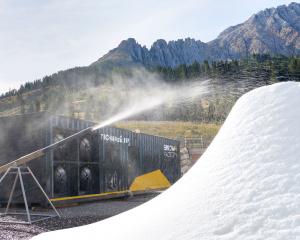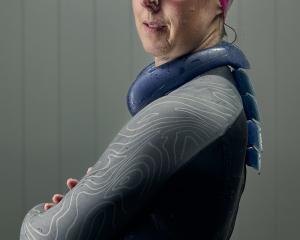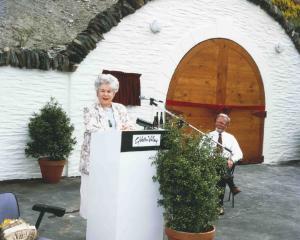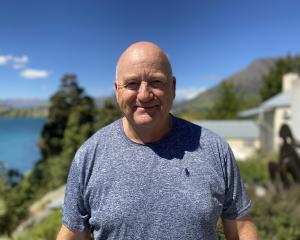A small American "water flea" that invaded New Zealand sometime in the past 10 years might be responsible for the crystal-clear state of the water in Lake Hayes, near Queenstown. The lake - possibly the most photographed in the country - began suffering from unsightly brown algal blooms in the summer of 2006. But there was no bloom last summer and a University of Otago study released this week suggests the reason could be the presence of Daphnia pulex. Mark Price reports.
It is a chubby, 2mm-long crustacean famous for being the first crustacean to have its genome unravelled but not for much else.
Daphnia pulex originated in America, has been in Europe and Australia for years and was first identified as being in New Zealand in December 2008.
How it got to New Zealand and into Lake Hayes is unknown, but University of Otago zoologist Dr Marc Schallenberg is suggesting its presence might be behind a startling improvement in the quality of the lake's water last summer.
Dr Schallenberg told the Otago Daily Times this week the lake had an "incredible clarity" which was "basically a record".
"Last summer, all the water-clarity measurements seemed to be beyond any previous measurement that had ever been taken going right back to the '50s."
The Lake Hayes problem began in the summer of 2006 when the water took on an unpleasant brown colour.
The cause was the blooming of the microscopic, one-celled dinoflagellate Ceratium hirundinella.
Ceratium is a yellow, brown or green native alga.
At the height of the problem in 2007, Fish and Game reported finding 60 dead ducks and 30-40 dead brown trout and others in "really emaciated" condition.
The pressure went on the Otago Regional Council to do something about it.
The council believed high levels of nutrient runoff from surrounding farmland was the primary cause of the bloom.
And because of "intense phosphorus loading" in lake sediment, it did not expect a rapid improvement.
Possible solutions costing up to $1 million were discussed.
Residents formed the Friends of Lake Hayes Society and, as a result of a collaboration between it, the council, the university and Niwa, various experiments were designed for the summer of 2010.
But, says Dr Schallenberg, Ceratium "just didn't show up. It didn't show up to the party."
The summer's unexpectedly clear water not only ruined several experiments designed to reveal the movement of Ceratium in the lake but others designed to measure the amount of phosphorus being released from lake sediments.
"So we were a bit confounded by the good news that Lake Hayes had improved remarkably."
What Dr Schallenberg and his intern, Dutch masters student Ciska Overbeek, did find on their first visit to the lake in early February was a great number of Daphnia pulex.
"We realised there was something going on with the Daphnia because, if you know what you are looking for, they are visible to the naked eye. There were so many of them."
Dr Schallenberg said they looked for other causes of the improvement in water quality and considered and discounted changes in water temperature.
"I would have expected, for the lake to flip so remarkably in one year, that there would be some really strong indicator temperature-wise, but there were just a couple of subtle effects that we feel probably aren't big enough to warrant the change that we observed."
Ceratium behaves and feeds like both a plant and an animal.
It is covered by an armour of textured plates and has few natural predators.
The arrival of Daphnia pulex seems to have changed that, although exactly how is a mystery.
Daphnia pulex is 10 to 20 times larger than Ceratium but because it filter feeds only on minute particles, it could not have eaten mature CeratiumDr Schallenberg: "It's possible it's fed on it when Ceratium is small or it's possible that it's changed the nutrient cycling.
"Daphnia feed and then they excrete nutrients so they may have actually increased the nutrient availability somehow in the water that prevented the Ceratium from becoming a competitive species. We don't know. We really just don't know.
"We need another year where Ceratium blooms so that we can actually work that one out, but of course we hope that that doesn't happen."
Although the presence of Daphnia pulex seems to have produced only positive effects on water quality, Dr Schallenberg says it is "basically excluding" the native Daphnia carinata.
"I guess from a biodiversity point of view, losing another native species is not good.
"But it's such a small animal that most people aren't even aware of it most of the time, and if it's being replaced by a Daphnia that is kind of more efficient ecologically in terms of clearing the water, then I guess to most people that would be a good thing."
University of Otago freshwater ecologist Carolyn Burns says it is important not to overstate the impact Daphnia pulex is having.
She was alerted to the presence of the foreign Daphnia in Lake Benmore in December 2008 by Niwa technician Karen Robinson.
Prof Burns went back to historic water samples from Lakes Moke, Johnson, Wakatipu, Wanaka and Hayes and found Daphnia pulex was not present in 1999 but it was there in 2005.
It was therefore in Lake Hayes before the blooms occurred and Prof Burns warned about jumping to conclusions over the part it might have played in the disappearance of Ceratium blooms.
"The mere fact that the Daphnia species is present in the lake, to my way of thinking, doesn't ipso facto mean you are going to have good water quality as long as Daphnia pulex is there.
"At the moment, the lake is very clear and because they've got Daphnia pulex in Lake Hayes, it's very easy to jump to the conclusion that Daphnia has cleared up the lake.
"But you can't actually really jump to that conclusion in the absence of more evidence that `a' is directly affecting `b'.
"It could be an indirect effect. It may be that the lake was just going to be clearer this year anyway for a whole lot of other reasons.
"I would just be a bit leery myself of giving it 100% of the credit until I knew that all the other things had been discounted."
Dr Schallenberg said it was "too bad" the number of Daphnia pulex in Lake Hayes was not known in 2005 so it could be compared with last summer.
"So clear answers about Lake Hayes' dramatic improvement remain elusive."
Dr Schallenberg has funding to study the effects Daphnia pulex has on other waterways as it spreads but is unlikely to do more work on Lake Hayes, unless Ceratium returns.
He points out that in the absence of Ceratium, fish numbers are likely to bounce back and young fish in particular find Daphnia pulex quite flavoursome.
Therefore, having a lot of young fish in Lake Hayes could restrict the Daphnia's population, giving Ceratium the chance to re-establish.
So fishermen, as they are reeling in their next big Lake Hayes trout, might like to contemplate this: The Daphnia disposes of the brown bloom (maybe). The little fish eat the Daphnia. The big fish eat the little fish. But if the big fish is in the frying pan ... ?











